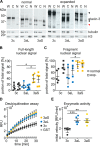Physiological and pathophysiological characteristics of ataxin-3 isoforms
- PMID: 30455355
- PMCID: PMC6333899
- DOI: 10.1074/jbc.RA118.005801
Physiological and pathophysiological characteristics of ataxin-3 isoforms
Abstract
Ataxin-3 is a deubiquitinating enzyme and the affected protein in the neurodegenerative disorder Machado-Joseph disease (MJD). The ATXN3 gene is alternatively spliced, resulting in protein isoforms that differ in the number of ubiquitin-interacting motifs. Additionally, nonsynonymous SNPs in ATXN3 cause amino acid changes in ataxin-3, and one of these polymorphisms introduces a premature stop codon in one isoform. Here, we examined the effects of different ataxin-3 isoforms and of the premature stop codon on ataxin-3's physiological function and on main disease mechanisms. At the physiological level, we show that alternative splicing and the premature stop codon alter ataxin-3 stability and that ataxin-3 isoforms differ in their enzymatic deubiquitination activity, subcellular distribution, and interaction with other proteins. At the pathological level, we found that the expansion of the polyglutamine repeat leads to a stabilization of ataxin-3 and that ataxin-3 isoforms differ in their aggregation properties. Interestingly, we observed a functional interaction between normal and polyglutamine-expanded ATXN3 allelic variants. We found that interactions between different ATXN3 allelic variants modify the physiological and pathophysiological properties of ataxin-3. Our findings indicate that alternative splicing and interactions between different ataxin-3 isoforms affect not only major aspects of ataxin-3 function but also MJD pathogenesis. Our results stress the importance of considering isoforms of disease-causing proteins and their interplay with the normal allelic variant as disease modifiers in MJD and autosomal-dominantly inherited diseases in general.
Keywords: E3 ubiquitin ligase; alternative splicing; deubiquitylation (deubiquitination); enzyme degradation; enzyme kinetics; genetic polymorphism; neurodegenerative disease; polyglutamine disease; protein aggregation; proteomics.
© 2019 Weishäupl et al.
Conflict of interest statement
The authors declare that they have no conflicts of interest with the contents of this article
Figures








Similar articles
-
The deubiquitinase function of ataxin-3 and its role in the pathogenesis of Machado-Joseph disease and other diseases.Biochem J. 2024 Mar 20;481(6):461-480. doi: 10.1042/BCJ20240017. Biochem J. 2024. PMID: 38497605 Free PMC article. Review.
-
Blood and cerebellar abundance of ATXN3 splice variants in spinocerebellar ataxia type 3/Machado-Joseph disease.Neurobiol Dis. 2024 Apr;193:106456. doi: 10.1016/j.nbd.2024.106456. Epub 2024 Feb 27. Neurobiol Dis. 2024. PMID: 38423193
-
Machado-Joseph Disease: A Stress Combating Deubiquitylating Enzyme Changing Sides.Adv Exp Med Biol. 2020;1233:237-260. doi: 10.1007/978-3-030-38266-7_10. Adv Exp Med Biol. 2020. PMID: 32274760 Review.
-
Mass spectrometry analyses of normal and polyglutamine expanded ataxin-3 reveal novel interaction partners involved in mitochondrial function.Neurochem Int. 2018 Jan;112:5-17. doi: 10.1016/j.neuint.2017.10.013. Epub 2017 Oct 27. Neurochem Int. 2018. PMID: 29111377
-
Increased transcript diversity: novel splicing variants of Machado-Joseph disease gene (ATXN3).Neurogenetics. 2010 May;11(2):193-202. doi: 10.1007/s10048-009-0216-y. Epub 2009 Aug 28. Neurogenetics. 2010. PMID: 19714377
Cited by
-
Valosin containing protein (VCP): initiator, modifier, and potential drug target for neurodegenerative diseases.Mol Neurodegener. 2023 Aug 7;18(1):52. doi: 10.1186/s13024-023-00639-y. Mol Neurodegener. 2023. PMID: 37545006 Free PMC article. Review.
-
The parkin V380L variant is a genetic modifier of Machado-Joseph disease with impact on mitophagy.Acta Neuropathol. 2024 Aug 1;148(1):14. doi: 10.1007/s00401-024-02762-6. Acta Neuropathol. 2024. PMID: 39088078 Free PMC article.
-
Impaired interactions of ataxin-3 with protein complexes reveals their specific structure and functions in SCA3 Ki150 model.Front Mol Neurosci. 2023 Mar 24;16:1122308. doi: 10.3389/fnmol.2023.1122308. eCollection 2023. Front Mol Neurosci. 2023. PMID: 37033372 Free PMC article.
-
Regional distribution of polymorphisms associated to the disease-causing gene of spinocerebellar ataxia type 3.J Neurol. 2024 Dec 12;272(1):54. doi: 10.1007/s00415-024-12829-9. J Neurol. 2024. PMID: 39666145 Free PMC article.
-
Altered Levels of Proteins and Phosphoproteins, in the Absence of Early Causative Transcriptional Changes, Shape the Molecular Pathogenesis in the Brain of Young Presymptomatic Ki91 SCA3/MJD Mouse.Mol Neurobiol. 2019 Dec;56(12):8168-8202. doi: 10.1007/s12035-019-01643-4. Epub 2019 Jun 14. Mol Neurobiol. 2019. PMID: 31201651 Free PMC article.
References
-
- Schmidt T., Landwehrmeyer G. B., Schmitt I., Trottier Y., Auburger G., Laccone F., Klockgether T., Völpel M., Epplen J. T., Schöls L., and Riess O. (1998) An isoform of ataxin-3 accumulates in the nucleus of neuronal cells in affected brain regions of SCA3 patients. Brain Pathol. 8, 669–679 10.1111/j.1750-3639.1998.tb00193.x - DOI - PMC - PubMed
-
- Ichikawa Y., Goto J., Hattori M., Toyoda A., Ishii K., Jeong S. Y., Hashida H., Masuda N., Ogata K., Kasai F., Hirai M., Maciel P., Rouleau G. A., Sakaki Y., and Kanazawa I. (2001) The genomic structure and expression of MJD, the Machado–Joseph disease gene. J. Hum. Genet. 46, 413–422 10.1007/s100380170060 - DOI - PubMed
Publication types
MeSH terms
Substances
LinkOut - more resources
Full Text Sources
Molecular Biology Databases
Research Materials

